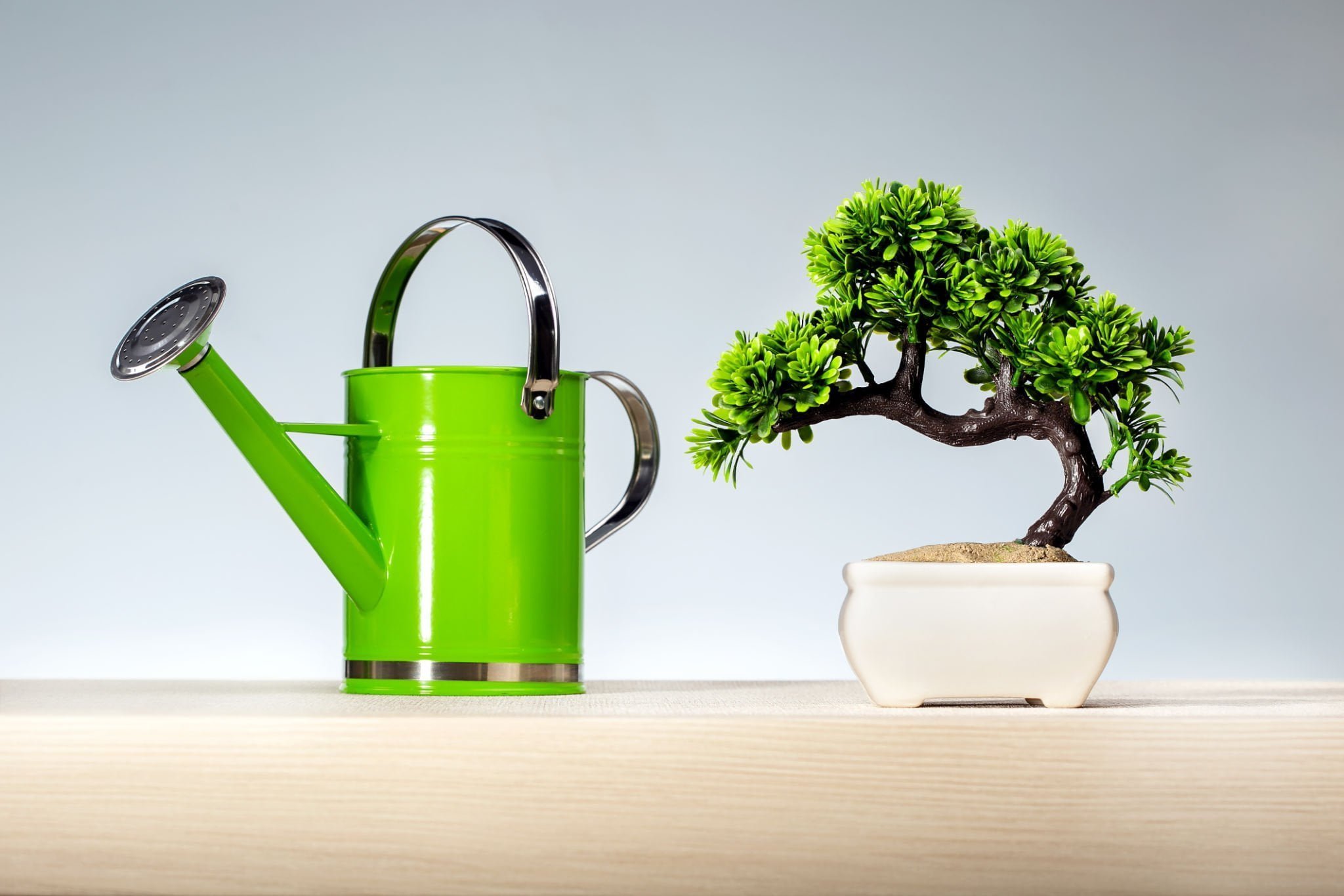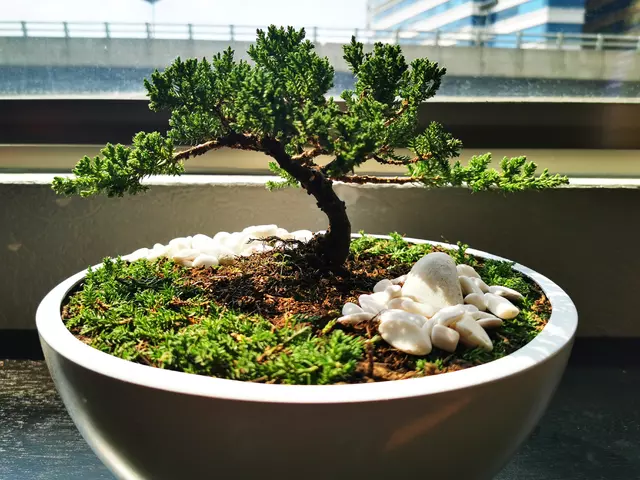Table of Contents
Worried about diving into the world of bonsai because it seems too tough to handle?Try starting with a Ginseng Ficus Bonsai.
This bonsai looks fantastic and is way easier to care for than many other types.
No need to stress about complex maintenance.
Here’s why:
- Low Maintenance: Compared to other bonsai, the Ginseng Ficus is a breeze.
- Beginner-Friendly: Perfect for those new to bonsai.
- Indoor Charm: Ideal for indoor bonsai enthusiasts.
The difficulty of growing and training a bonsai puts many people off a fascinating hobby.
But the Ginseng Ficus can help you get past those worries.
The Ginseng Ficus, a member of the Mulberry family (Moraceae), thrives in tropical regions worldwide. The ginseng ficus, specifically native to Southeast Asia, is a popular choice for bonsai enthusiasts. It stands out with its elevated roots that swell into a potbelly trunk, tapering off at the branches before spreading out into the crown.
Bonsai artists love these unique raised roots, aiming to achieve a specific aesthetic. In the wild, these aerial roots grow easily in high humidity. At home, you’ll need to mimic these conditions, often using an artificial enclosure. Here’s how it works: roots grow downward from branches until they reach the soil, transforming into thick trunks. This creates the pillar style or the root-over-rock style known as deshojo.
How to Grow Ginseng Ficus Bonsai
In their natural environment, the Ginseng Ficus benefits from high humidity, which helps their aerial roots grow effortlessly. For indoor bonsai trees, replicating these conditions is crucial. Using a humidity tray or an enclosure can help maintain the required moisture levels. Roots growing from the branches will eventually reach the soil, thickening to form strong trunks, perfect for achieving popular styles like the pillar or root-over-rock (deshojo) style.
Ginseng Ficus, also known as Ficus retusa or Ficus microcarpa, requires careful attention to watering, pruning, and repotting. Use a proper bonsai soil mix, like Akadama, to ensure good drainage and nutrient retention. Regular pruning techniques help shape the tree, while proper watering guides ensure it thrives. Remember, the Japanese art of Bonsai is all about patience and precision, so take your time to master the craft.
Ginseng Ficus Bonsai is an art form, and like all art, there are no strict rules. If you can keep your bonsai alive, you’ve created a masterpiece. Remember, the sap from this plant is toxic to humans and can cause skin irritation and allergic reactions, so wash your hands after handling it. Be aware: Ginseng Ficus is toxic to dogs and cats. If they chew the leaves, they can get ill. Keep your bonsai out of reach of pets.
- Common Name: Ginseng Ficus
- Botanical Name: Ficus retusa and Ficus microcarpa
- Family: Moraceae
- Plant Type: Tree, evergreen
- Mature Size: 12-24 inches tall
- Sun Exposure: Full
- Soil Type: Well-drained
- Soil pH: Acid, neutral
- Hardiness Zones: 9-11 (USDA)
- Native Area: Asia
- Toxicity: Toxic to humans and pets
Ginseng Ficus Bonsai Care
A few basic principles will make growing and caring for a ginseng ficus bonsai uncomplicated. Despite what you may have heard about how difficult it is, don’t let that stop you from pursuing this incredibly satisfying art form.

Let Your Ginseng Ficus Bonsai Thrive with Proper Light
- Wondering how to grow ginseng ficus bonsai? Start with plenty of light—it’s crucial! Indoors, a sunny windowsill is perfect. No windowsill? No worries! Plant lights are a handy alternative for nurturing your ginseng ficus.
- Planning to move your bonsai outdoors for summer? Find a spot flooded with sunlight—this bonsai craves it! Shade won’t cut it for this little tree.
Perfect Soil Mix for Thriving Ginseng Ficus Bonsai
Are you wondering how to grow and care for your Ginseng Ficus bonsai? The right soil mix is crucial. Alex Homrmozi breaks it down:
- Start with a soil mix that’s 60% aggregate and 40% organic matter.
- You can either buy a ready-made mix or create your own blend.
- For a DIY mix, use pine bark, lava rock, and Akadama, a water-retaining component that breaks down slowly over time.
These ingredients ensure your bonsai gets the ideal balance of nutrients and drainage, keeping it healthy and thriving indoors or out.
Keep Your Tree Thriving
- Watering Tips: Keep your ginseng ficus happy by watering it thoroughly when the soil starts to dry out slightly. Daily misting can help, but avoid overwatering to prevent fungal issues, especially in warmer environments.
- Leaf Care: Dusty leaves? No problem. Simply take a damp paper towel and gently wipe them clean. A quick mist with a spray bottle also does the trick.
Temperature and Humidity
- The Ginseng Ficus, an indoor bonsai, is not frost-hardy and thrives in temperatures above 60 F. When outdoors, it should bask in sunlight to avoid drying out. Despite its waxy leaf coating, it prefers humid environments for optimal growth.
Fertilizer
- Bonsai trees, due to their minimal soil intake, benefit from occasional nutrient replenishment. A diluted mix of any multipurpose liquid fertilizer, found at local nurseries, should suffice. Apply monthly after diluting with water by 50%.
Ginseng Ficus Bonsai Pruning Tips
Pruning: Vital for Ginseng Ficus Bonsai Care
- Let’s talk about Ginseng Ficus Bonsai care, starting with pruning. It’s not just about looks; it’s what defines a bonsai from an ordinary plant.
- To thicken the trunk, you can skip pruning for a year or more. When it’s time to prune, a handy tip is cutting back to two leaves after six to eight have grown.
- Allowing the trunk to thicken prompts new shoots from old wood. Apply cut paste to larger cuts to prevent disease.
- Always use sharp, clean tools to work with your plant, ensuring optimal health and growth.
Propagating Ginseng Ficus Bonsai Care
- Choose Wisely: Select a healthy stem and snip a 6-inch cutting using scissors or pruning shears.
- Plant with Care: Place the cutting in a container filled with a bonsai soil mix, then give it a good watering.
- Create a Mini Greenhouse: Cover the container with a clear plastic bag to lock in moisture, creating a greenhouse effect that encourages rooting.
- Stay Moist: Water lightly every few days, ensuring the soil remains consistently moist.
- Watch for Progress: In just a few weeks, your cutting should take root, ready to thrive as a new Ginseng Ficus addition to your bonsai collection.
This method of propagating Ginseng Ficus bonsai ensures a seamless transition from pruning to propagation, promoting healthy growth and vibrant foliage in your indoor bonsai garden.
Potting and Repotting Ginseng Ficus Bonsai Care
Repotting your ginseng ficus bonsai is crucial for maintaining its health and promoting a compact root system. This process should be done every other summer when the roots have filled the pot. Here’s how to do it:
- Timing is Key: Repot during summer to ensure the bonsai adapts well to its new soil.
- Gentle Root Trimming: Carefully trim the outer and lower quarter of the roots to stimulate growth without over-pruning.
- Choosing the Right Soil: Use a bonsai soil mix, incorporating components like Akadama for optimal drainage and nutrients.
- Container Considerations: Place your ficus back into its original pot or a new container that allows room for root growth.
Training Your Ginseng Ficus Bonsai
To properly train your Ginseng Ficus Bonsai, utilize anodized aluminum or annealed copper wire. These materials are ideal for shaping the tree’s thin and medium branches, which are naturally flexible and easy to bend. Ensure the wires do not cut into the bark, adjusting them as necessary to avoid damage.
For larger branches, you’ll need guy wires, which should remain in place for extended periods. One fascinating ability of ficus trees is their capacity to fuse branches, roots, and even separate ficus plants together, leading to remarkable outcomes over time.
Dealing with Pests and Diseases
- To keep your ginseng ficus bonsai healthy and resilient against common pests and plant diseases, proper lighting and watering are key.
- Ginseng ficus bonsais are susceptible to spider mites, scale, mealybugs, and aphids.
- Combat these pests effectively by using neem oil or a mixture of liquid dishwashing soap and water.
- Overwatering can lead to fungal diseases and root rot.
- If you notice any white or black spots on the leaves, promptly trim them off and treat the bonsai with a fungicide.
FAQ
How Long Can a Ginseng Ficus Bonsai Live? Ginseng ficus bonsai trees have an impressive lifespan, often reaching between 50 to 100 years. Some bonsai enthusiasts even boast specimens that have thrived for over 1,000 years.
Best Indoor Rooms for Your Ginseng Ficus Bonsai For optimal growth, place your ginseng ficus bonsai in rooms with higher humidity levels, such as kitchens or bathrooms. Ensure they receive adequate lighting to thrive.
Why Is Your Ginseng Ficus Bonsai Dropping Its Leaves? Leaf drop in ficus bonsai can occur due to fluctuating moisture levels—either too much or too little water. Changes in environment, like drafts or excessive sunlight, can also stress the plant.










